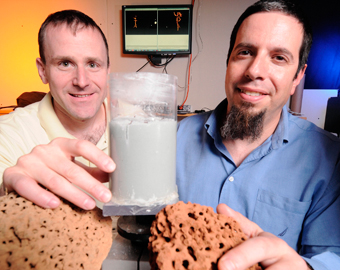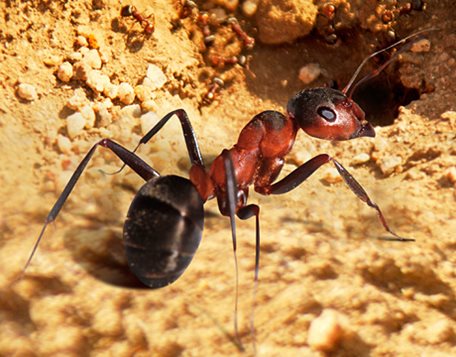Georgia Institute of Technology researchers who are studying fire ants in the laboratory have discovered some unique approaches to underground locomotion that could revolutionize the design of tunneling equipment and remote robotic diggers, increasing their productivity and safety underground.
Remarkably little is known about how underground organisms construct, inhabit, and move within confined spaces so efficiently, while dealing with loco-motor challenges such as limited limb range of motion, crowding, and visual sensory deprivation. To gain insight into how these insects move efficiently within confined spaces, Georgia Tech biology professor Michael Goodisman, physics professor Daniel Goldman, graduate student Nick Gravish, and postdoc student Daria Monaenkova studied the locomotion of the fire ant Solenopsis invicta, which is well known for its extensive subterranean tunnel networks.
Why fire ants?
"These animals dig virtually non-stop and are good, repeatable study subjects," says Goodisman. "They are also very convenient to study. We can go outside the laboratory door and collect them virtually anywhere."
"We think that the ants are creating their environment in just the right way to allow them to move up and down rapidly with a minimal amount of neural control," adds Goldman. "Their environment allows the ants to make missteps and not suffer for them. These ants can teach us some remarkably effective tricks for maneuvering in subterranean environments."
Experiment Methodology
 |
| Georgia Tech researchers Daniel Goldman and Michael Goodisman pose with a tube containing simulated soil used to study tunnels being made by fire ants. Image: Gary Meek / GATech.edu |
Guided by the hypothesis that ants have developed strategies and adaptations for rapid movement within nests, particularly during crucial times such as nest reconstruction or evacuation, Goldman and his research team placed groups of fire ants into tubes of soil and allowed them to dig tunnels for 20 hours. Soil particle size and soil moisture content were varied to simulate different environmental conditions.
Video equipment captured the ants moving and digging. X-ray computed tomography (CT) was used to study the dimensions of the tunnels the ants created. To examine the limits of slip-recovery in artificial tunnels, the maze of tunnels was periodically dropped with a force of as much as 27 times that of gravity. This sudden movement dislodged about half of the ants in the tubes from the walls; their methods of recovery were captured on video.
Surprising Results
The Georgia Tech team published its research May 20 in theProceedings of the National Academy of Sciences. Although variations in particle size and moisture content did impact the volume of tunnels produced, X-ray CT scans showed the tunnel diameter remained constant and was independent of soil type.
"Regardless of whether the soil particles were as large as the animals' heads or whether they were fine powder, or whether the soil was damp or contained very little moisture, the tunnel size was always the same within a tight range," says Goldman. "The size of the tunnels appears to be a design principle used by the ants, something that they were controlling for."
Perhaps the most intriguing result was video that showed how ants responded to the sudden falls that sent them tumbling from the walls of their tunnels—their falls were always arrested through rapid interaction of appendages and antennae with tunnel walls.
"Many [of] us who have studied social insects for a long time have never seen antennae used in that way," said Goodisman. "It's incredible that they catch themselves with their antennae. This is an adaptive behavior that we never would have expected."
Future Possibilities
"Little is known about the control and mechanics principles used by organisms in confined environments," says Goldman. "I think learning the principles that high-performing organisms use to negotiate complex environments like these could be of interest to engineers who wish to design the next generation of mobilerobots."
Further research could define locomotion principles that could create robotic devices that can move within confined environments such as search and rescue zones with more speed, efficiency, and safety. "We propose that future robot teams could enhance survival in harsh terrestrial and extraterrestrial environments through collective construction of appropriately engineered shelters and nests," says Goldman.
"The problems that the ants face are the same kinds of problems that a digging robot working in a confined space would potentially face—the need for rapid movement, stability, and safety—all with limited sensing and brain power," concludes Goodisman. "If we want to build machines that dig, we can build in controls like these ants have."



.jpg)

0 comments:
Post a Comment